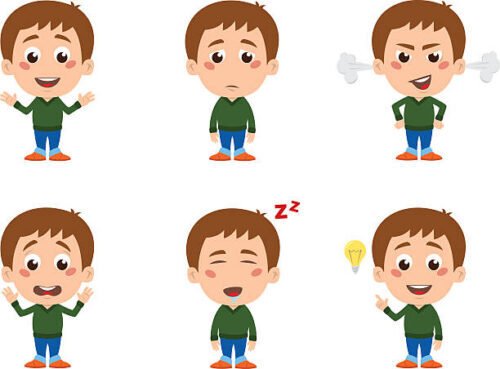Introduction
Boys can sometimes be a puzzle, leaving us with more questions than answers when it comes to their behavior and emotions. But what if we told you that gaining a deeper understanding of boys is simply a matter of knowing some key facts about boys?
However, once you begin to get a glimpse into the world of boys and understand them on a deeper level, you may be amazed at their potential and the positive impact they can have on your life. Whether it’s their unique perspective on the world, their boundless energy, or their infectious laughter, there’s no denying that boys have so much to offer. In this blog, we’ll explore some fascinating facts about boys that will help you to better understand this complex and amazing demographic. From their physical and emotional development to their education and hobbies, we’ll uncover the many layers that make up the lives of boys and the valuable role they play in our world. So, join us as we delve into the exciting world of boys!
10 Lesser-Known Facts About Boys.
Boys typically develop language skills later than girls do
Several factors, according to research, contribute to the language development gap between boys and girls. One factor is that girls’ auditory processing skills are more developed, allowing them to understand language and speech better. Boys, on the other hand, have stronger visual-spatial skills that can take longer to develop.
Another factor is that boys are more physically active and engage in rougher play, which can sometimes interfere with their language development. Furthermore, boys may be more prone to attention problems, such as ADHD, which can affect their language development.
Boys are not born with gender-specific interests–they are strongly influenced by their environment and culture
For generations, society has perpetuated the notion that boys are naturally inclined towards certain activities and interests, while girls are naturally inclined towards others. However, recent research has shown that boys are not born with gender-specific interests, and that these interests are largely influenced by the environment and culture in which they are raised.
Studies have shown that boys’ interests are shaped by a variety of factors, including the toys and activities they are exposed to, the messages they receive from the media, and the gender expectations placed on them by their parents, teachers, and peers.
For example, if a boy is exposed to toys and activities that are marketed as “for boys,” such as action figures and sports equipment, he is more likely to develop an interest in those activities. Similarly, if a boy is surrounded by messages that suggest that certain activities, such as cooking or dancing, are “not for boys,” he is less likely to pursue those interests.
Also read: 10 Advantages of Offline Classes [The Real Truth]
Boys typically mature more slowly than girls, both physically and emotionally.
Boys tend to mature more slowly than girls in both physical and emotional development, which is supported by scientific research. Physically, boys have a slower rate of growth, take longer to reach full height and develop muscle mass, and typically reach puberty later than girls. Emotionally, boys are slower to develop the emotional intelligence and empathy required for healthy relationships and successful social interactions.
This can lead to challenges in school, where boys may not be as prepared as girls for academic and social demands, and in relationships, as boys may have trouble connecting with others and communicating effectively. Despite this, it is important to note that every child develops at their own pace and there is a wide range of normal development.
Boys have stronger visual-spatial skills
Boys are believed to have stronger visual-spatial skills and more intense interests in math and science, which contributes to their better performance in these subjects. Studies have shown that boys have an advantage in visual-spatial skills and are more engaged in subjects like physics, chemistry, and engineering.
However, this difference in performance is not absolute and may be influenced by cultural and societal factors. It is important to support both boys and girls to pursue their interests and reach their full potential in all subjects.
Boys are more likely to express their emotions through physical outlets
It is commonly observed that boys tend to express their emotions through physical outlets rather than through verbal communication. This is due to the different ways that boys and girls are socialized and the societal expectations placed on them to conform to gender norms.
Boys are often encouraged to engage in physical activities and rough play, and to suppress their emotions and avoid expressing them verbally. This can lead to boys feeling frustrated or overwhelmed by their emotions, but feeling unsure of how to express them. As a result, they may turn to physical activities, such as sports or play, as a way to release their emotions.
Also read: Cricket 101: Interesting Facts About Cricket
Boys have greater spatial awareness.
The male brain has a more developed area for spatial awareness and motor coordination, while the female brain has a more developed area for language processing and emotional regulation” – This statement highlights the differences in the structure of the male and female brain, which has been extensively studied by scientists and researchers.
This structural difference has a significant impact on how boys and girls perceive and process information and also influences their behavior and abilities. Boys tend to excel in activities that require spatial awareness, such as map reading, solving puzzles and playing sports, while girls tend to perform better in activities that require language skills, such as verbal communication and writing. This difference in brain structure is not absolute and can be influenced by various other factors, such as environment and experience.
However, it is an interesting and important aspect to understand when it comes to the development and well-being of boys.
Boys are more likely to experience learning difficulties, such as dyslexia and ADHD
It’s a commonly accepted belief that boys are more likely to suffer from learning difficulties such as dyslexia and ADHD than girls. However, recent research suggests otherwise. The higher frequency of diagnoses among boys could be due to the difference in the way symptoms are presented between the two genders.
Dyslexia, a neurodevelopmental disorder affecting reading, writing, and language skills, is diagnosed more frequently in boys with a ratio of 4:1. However, girls with dyslexia are often misdiagnosed or not diagnosed at all as their symptoms may be more subtle and not fit the typical profile of dyslexic males.
ADHD (Attention Deficit Hyperactivity Disorder), a disorder impacting attention, impulsivity, and hyperactivity, also shows a higher frequency of diagnoses among boys with a ratio of 3:1. Similarly, girls with ADHD may not be diagnosed as frequently as their symptoms may not be as noticeable or present differently.
It’s crucial to remember that these learning difficulties can impact individuals of any gender and proper assessments and diagnoses are essential for them to receive the support they need to reach their full potential.
- Reference: ADHD and Dyslexia: Living Well With a Double Diagnosis
- ADHD and Dyslexia: Implications on School and Work Environments
Boys may struggle with expressing emotions
Boys often face pressure to suppress their emotions due to societal norms and gender stereotypes that view emotions as weak or unmanly. This can result in difficulties in regulating emotions and expressing their feelings.
These difficulties can have negative impacts on their mental and physical health, relationships, and overall well-being. It is important for society to challenge these harmful stereotypes and norms and to provide a safe and supportive environment for boys to express their emotions.
Encouraging boys to talk about their feelings and emotions can lead to improved emotional intelligence, better relationships, and improved mental health. By promoting healthy emotional expression for all individuals, we can work towards a more equitable and emotionally intelligent society.
Also read: 10 Interesting Facts and Information About the Neem Tree
Boys Tend to Have Better Stress Management Skills.
Depression is a widespread mental health condition that affects individuals of all genders, yet research has indicated that boys may be more susceptible to depression than girls. This disparity can be attributed to a range of factors, including societal expectations, cultural norms, and disparities in the way depression is diagnosed and treated.
One of the reasons why boys may be more susceptible to depression is due to societal expectations that promote the suppression and concealment of emotions. This can make it challenging for boys to recognize and express their sadness and hopelessness, leading to an increased risk of depression. Additionally, the pressure to be tough and self-reliant can make it difficult for boys to seek help for mental health issues, including depression.
Research has indicated that boys with depression are often misdiagnosed or not diagnosed at all due to differences in the presentation of symptoms compared to girls with depression. Boys may be more likely to engage in risky behaviors, such as substance abuse or aggression, which can be indicative of underlying depression.

Boys have a higher risk of developing autism compared to girls.
Left-handedness is a trait that has fascinated researchers and the general public for decades. Statistics show that around 10-12% of the population identifies as left-handed, and that this group includes a slightly higher proportion of males than females.
While the exact cause of this disparity is still not fully understood, several theories have been proposed. Some researchers believe that genetic factors play a significant role in determining handedness, and that the genes associated with left-handedness are more common in males. Others have proposed that hormonal factors during pregnancy and early childhood may influence the development of handedness.
Despite the speculation, the exact reason for the higher prevalence of left-handedness among males remains a mystery. However, what we do know is that left-handedness is a normal variation in the population and should not be seen as a disadvantage. Today, society is becoming increasingly accommodating of left-handed individuals, and left-handed products are more widely available than ever before.
Also read: “Facts about Constitution of India: An In-Depth Exploration”
Research of Boys psychology
Facts about boys suggest that there is a need for increased research in the field of boy psychology to better understand the unique experiences and challenges faced by this demographic.
The study of boy psychology has been an area of research and interest for many years, with numerous studies exploring various aspects of boys’ development, behavior, and mental health. Researchers in this field have sought to understand the unique challenges and experiences that boys face, and to develop effective interventions and support systems to help them thrive.

One of the key areas of research in boy psychology has been the exploration of gender differences in brain development and cognition. Studies have found that, on average, boys tend to be better at certain skills, such as spatial awareness and mathematical ability, while girls tend to perform better in language and verbal tasks.
Another important area of research in boy psychology has been the examination of emotional and behavioral difficulties that boys may experience. Studies have shown that boys are more likely to engage in delinquent behavior, suffer from depression, and have difficulties with emotional regulation and expression. Researchers have also explored the impact of cultural and societal factors, such as gender stereotypes and expectations, on boys’ mental health and well-being.
In addition to these areas of research, boy psychology has also explored the development of healthy relationships, positive identity formation, and effective coping mechanisms for boys. By taking a comprehensive approach to understanding boys’ unique experiences and challenges, researchers in this field are working to promote healthy development and well-being for boys of all ages.
Also read: 10 must Read books on Indian history.
Social Development of Boys
With the knowledge of some facts about boys, let’s examine their development stages. Independence and autonomy are crucial components of boys’ social development, as demonstrated by their preference for solitary play and reluctance to seek adult assistance. During early childhood, boys tend to engage in more physical play than girls, which enhances their coordination, balance, and gross motor skills. However, as they reach adolescence, boys face new challenges in their social development, such as peer relationships and social anxiety.
It’s vital for adults to create a supportive environment that fosters boys’ confidence and self-worth, promoting healthy social development. Moreover, the regulation of emotions and behavior is a significant aspect of boys’ social development, impacting their ability to effectively navigate social interactions and form positive relationships. With proper support and guidance, boys can develop robust social skills that will benefit them throughout their lives.
Cognitive Development of Boys
The field of boy psychology has extensively studied the cognitive development of boys and its impact on their overall well-being. Many researchers have focused on exploring gender differences in brain development and cognition, with facts about boys suggesting that, on average, they tend to be better at certain skills such as spatial awareness and mathematical ability. These differences have been attributed to a combination of biological, environmental, and cultural factors.
In terms of cognitive development, boys are often seen as more active and physically oriented, which can impact their learning and development in different ways. Research has shown that boys tend to perform better in hands-on, experiential learning environments, and are more likely to engage in physical activities that stimulate their brains and bodies. This can help support their cognitive development by providing them with opportunities to explore, experiment, and problem-solve.
However, the fact that boys are more easily distracted and have a shorter attention span than girls has also been a topic of discussion in the field of boy psychology. Research has suggested that this difference can be attributed to a variety of factors, including differences in brain structure and functioning, as well as cultural and societal expectations placed on boys.
In conclusion, the cognitive development of boys is a complex and multi-faceted topic that requires a comprehensive understanding of the unique experiences and challenges faced by this demographic. By continuing to study and explore these areas, researchers in the field of boy psychology are working to support healthy cognitive development and promote well-being for boys of all ages.
Also read: 10 Underrated Bollywood Actors Who Are Destined for Greatness
Emotional Development of Boys
Emotional development is an important aspect of growing up for boys. During their childhood and teenage years, boys go through various stages of emotional development that shape their understanding of their own feelings and those of others. One of the key facts about boys is that they typically have a more limited vocabulary for expressing their emotions compared to girls. This can make it difficult for them to articulate their feelings and understand their own emotions. It is important for parents, caregivers, and teachers to be aware of this and provide boys with the tools they need to identify and communicate their emotions.
Another fact about boys is that they tend to experience intense emotions and may struggle with regulating them. This can result in outbursts of anger or frustration, especially during the teenage years when hormonal changes are taking place. It is important for boys to be taught coping mechanisms for managing their emotions, such as deep breathing and mindfulness, so that they can navigate these challenges effectively. Boys also tend to express their emotions differently from girls. They may be less likely to show affection or talk about their feelings, and instead may engage in physical activities or engage in risk-taking behavior. This is why it is important for boys to have positive male role models in their lives who can help them understand and express their emotions in a healthy way.
In conclusion, facts about boys highlight the importance of emotional development in shaping their futures. By providing boys with the tools and support they need to understand and manage their emotions, we can help them to become well-rounded and emotionally intelligent individuals.
- Who Should Be Your Trusted Granite Exporter in India?
- What is Countervailing Duty? Why Do Countries Impose It?
- How to Choose the Right SIP Investment Plan for You?
- Reasons to choose the Best Office Interior Designers in Kochi
- How To Choose A Fine Dining Restaurant For A Family Dinner?







7 Comments
Pingback: Cricket 101: Interesting Facts About Cricket - TheTop10spot
Pingback: "Facts about Constitution of India: An In-Depth Exploration"
Pingback: 10 must Read books on Indian history. - TheTop10spot
Pingback: DOREAMON SONG LYRICS IN DIFFERENT LANGUAGES
Pingback: Top 10 Toughest Exams In India [Updated 2023]
Pingback: 10 Advantages of Offline Classes [The Real Truth]
Pingback: 10 Biggest Production house in India [2023] - TheTop10spot